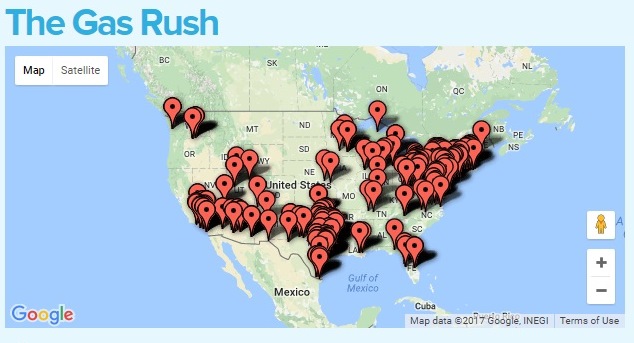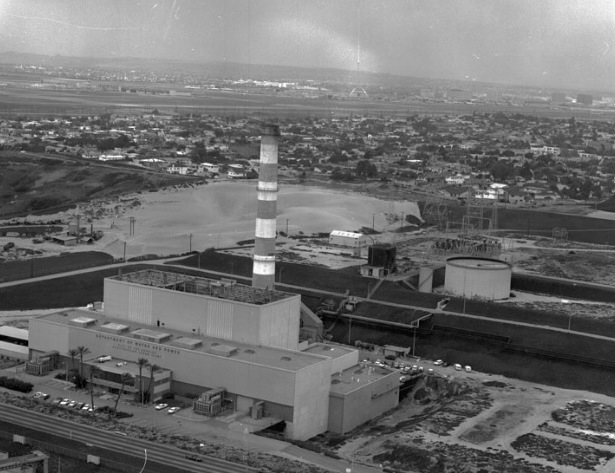Note: This post has been updated to address reader questions about Los Angeles’ overall track record on climate and the state regulation informing the utility’s decision to replace its aging fleet with new power plants.
In January, the Sierra Club released a new report, “The Gas Rush: Locking America Into Another Fossil Fuel for Decades.” The analysis captures the full scope of the proposed build out of natural gas infrastructure across the country, from new power plants to pipelines. In total, there are proposals to build 200 new gas plants, totaling 111 gigawatts of additional gas capacity.

View the report and the interactive map HERE.
Looking at the map, it’s easy to spot the clusters of gas: Texas, Pennsylvania, North Carolina, and Virginia all rank in the top five states driving natural gas expansion. In fact, just five states are driving more than half of the build out. The fifth state? California, and at the heart of the dash for gas is the city of Los Angeles.
Wait, what?
Yes, Los Angeles’s utility the Department of Water and Power (DWP) is proposing a major commitment to new natural gas power plants that risks locking the utility into fossil fuels for decades to come. If Los Angeles were ranked as a state, it would rank 10th among states in the report; the city is responsible for 2,882 MW of new natural gas power plants. Locally, DWP proposes 1,682 MW of new gas across three power plants: 346 MW at Scattergood Generating Station; 1,090 MW at Haynes Generating Station; 246 MW at Harbor Generating Station.
An additional 1,200 MW of gas generation is proposed in Utah at the site of Intermountain Power Plant, as DWP proposes to shift from one fossil fuel (coal) to another (gas) (The Utah power plant replaces a larger 1,850 MW coal plant. LADWP has not finalized plans for the plant in Utah and they are on record stating that the plant could be smaller, and LADWP’s share of the plant smaller still as they are building the power plant with other much smaller utilities. Still, their filing at the Energy Commission from last year requests approval for a 1,200 MW facility). All of this comes on the heels of DWP recently building 1,097 MW of gas power plants over the past 4 years, while purchasing another 531 MW gas power plant in Nevada.
So, what is going on here? In 2010, the State Water Resources Control Board finalized a rule ending the use of ocean water to cool coastal power plants. It should come as no surprise that burning things to create electricity creates a lot of excess heat, and historically power plants have used water manage this heat. This is why you see a lot of power plants along the coast. The ocean, afterall, has a lot of water. But, when power plants suck in water, they also suck in marine life, and they dump hot water back into the ocean, harming the aquatic habitat around the plant. Ending this practice and shifting to dry-cooling towers was a major victory for the environment. You can read more about the rule here.
Principally, the rule brought an end to the practice of using ocean water at power plants, but it forced some other important questions for utilities. In short: retire or rebuild? Most of the plants impacted by the rule were built decades ago, and so were old, inefficient, and polluted our air as well. Rather than just shift to dry cooling, California utilities proposed retiring some power plants outright, while using the opportunity to finance new power plants throughout the state that were more efficient and avoided ocean water.
Sierra Club’s My Generation campaign has fiercely opposed these new plants, particularly in Edison and SDG&E territory. Throughout the Public Utility Commission (PUC) proceeding that determined how to replace the retiring power plants across investor-owned utility service territory, Sierra Club and Earthjustice argued that, among other things, future efficiency and rooftop solar growth would obviate the need to replace these power plants. Rather, they should simply retire. And, while San Onofre’s retirement further compounded the issue, rooftop solar and efficiency growth have outpaced even Sierra Club’s optimistic expectations. For example, the PUC approved a 500 MW gas plant in Carlsbad, based on 2012 regional electricity demand projections. But, thanks to efficiency and rooftop solar, demand projections have fallen 700 MW since 2012. So, SDG&E customers are going to shell out more than $2 billion over the next 25 years for a power plant they don’t need. In short, utilities continue to press for new gas plants, despite declining overall demand and cleaner, more cost-effective alternatives.
OK, back to LADWP. The utility is in the midst of implementing its compliance plan for the ocean water cooling rule. It sought and received an extended timeline, and thus has until 2030 to fully comply with the rule. It is choosing to tear down its old coastal power plants and rebuild them as new, “state of the art” power plants that will run through the middle of this century. This is, almost certainly, a mistake. It’s sort of like abandoning a rotary phone for a flip phone: it’s progress, but now you’re the not so proud owner of a flip phone. The decision feels like an upgrade, but it’s one that we’ll quickly come to regret, as technology rapidly evolves.
Now, DWP waves away the new power plants problem, pointing to overall declining fossil fuel use, increased reliance on clean energy, and ambitions efficiency goals - actions that Sierra Club applauds. It’s also true that figuring out how to replace gas plants with clean energy is complicated, certainly more complicated than a blog post can do justice to. This is all to say that DWP is doing some really great things they should be commended for, and they’re also currently planning to spend a huge sum of DWP customer money on new polluting power plants ($630m for Scattergood alone) that tether us to natural gas for decades. This latter action should be scrutinized, challenged, and ultimately resisted vigorously.
If you couldn’t already tell, Sierra Club is extremely concerned about these long term commitments to new power plants. We’ve spent the last 8 years pushing to accelerate the city’s transition away from coal, and fear a similar scenario with gas, where we’re stuck with costly, regrettable investments and want a do-over. Recently, Earthjustice and Sierra Club recently submitted comments to DWP that lay out our concerns. You can read them here. The city’s plans for plants raise several concerns, ranging from high cost and stranded assets to reliability and air quality, clean energy, and more. I want to expand on one simple point touched on, albeit briefly, in our comments: it is very hard to square DWP’s plans to lock in decades of new dirty power plants with the City Council and Mayor’s publicly stated climate and clean energy goals.
In recent years, Los Angeles has taken some important steps to fight climate change, while signaling even bigger (and necessary) ambitions in recent months. In September, the Los Angeles City Council unanimously passed a motion requesting DWP study and develop a plan for 100 percent clean energy. The motion reads, “Today, with the LADWP on the verge of making significant investments in infrastructure ... the city has an opportunity to re-create its utility in a way that recognizes the potential for a fossil-free future, demonstrates global leadership limits commitment to clear energy, and protects ratepayers from the increasing costs of carbon-based fuels.”
Near the end of November, Mayor Garcetti committed L.A. to being among the first cities to explore and pursue every possible strategy for doing its part to limit global temperature rise to 1.5°C in an address to the C40 Cities Climate Leadership Group. Analysis indicates that emissions need to be upwards of 95 percent lower by 2050, with an added emphasis on rapid transformation of the electric sector.
No doubt, pursuing policies to phase out fossil fuels and limit warming to 1.5 is hard and critical work; it’s the type of bold leadership we need. But it’s absolutely true that the utility’s plans place DWP in conflict with the Mayor’s own commitment and impedes the City Council’s goal of moving away from “significant investments” in fossil fuels. We know that natural gas is a major contributor to climate change, and methane leaked in pipelines or storage facilities is an even more potent climate pollutant. Climate science demands that utilities rapidly decarbonize, and rebuilding these power plants commits Los Angeles to burning fossil fuels through 2050 and beyond.
Look, it’d be silly and possibly self-serving to argue that Los Angeles isn’t doing a lot to fight climate change. This post is not intended as a comprehensive environmental scorecard for the utility or the city. DWP is jettisoning coal, increasing its use of renewable energy, cutting energy demand, and electrifying its vehicle fleet. We’re focusing here on what we view as a substantial threat to a proud and growing record when it comes to the environment. Rebuilding these power plants not only cuts against the city’s record of leadership on climate, but constrains further climate action in the years to come. Once these power plants are built, they’re going to run for decades. Furthermore, these power plants siphon money from clean alternatives and limit the renewable energy and other technologies we’ll need to adequately reduce our greenhouse gas emissions.
It doesn’t have to be this way.
While the dash to gas is sobering, we’ve been here before. In early 2000s, the Bush Administration proposed more than 200 coal plants - threat to all breathers and current and future generations threatened by a warming planet. In the midst of the rush, Los Angeles was first to step up and say no. It helped negotiate the retirement of the highly polluting Mojave Generating Station, and said no to a proposal to expand the Intermountain Power Project. Today, the area on the IPP site where the third unit was proposed sits vacant. The effort to shift away from coal, ditching Mojave and later IPP’s proposal to expand was led by a young and bold Councilmember named … Eric Garcetti.
Now, in the midst of the gas rush, the Mayor’s leadership is needed again. Angelenos and many more are counting on Los Angeles to be a source of climate inspiration in the coming years. Los Angeles was an early symbol in the fight against coal and it can be again when it comes to natural gas. But, time is tight: DWP wants to move ahead now with its next expenditure - a $630 million 346 MW of the Scattergood Generating Station. Our city has long been a leader in the fight against climate change, but that’s now at risk as the city contemplates a multi-billion dollar investment in fossil fuels. It’s simple: Los Angeles can build its power plants, or it can lead on climate. But it can’t do both. It’s time for the Mayor to step up again and tell DWP to scrap its polluting plan and follow through in developing its plan for 100 percent clean energy.
